Physical Address
304 North Cardinal St.
Dorchester Center, MA 02124
Obstetric hemorrhage is one of the leading causes of maternal mortality throughout the world. Despite treatment protocols, postpartum hemorrhage remains the primary reason for maternal admissions to the intensive care unit, need for transfusion, and associated morbidity (e.g., acute lung injury, infection, coagulopathy, renal failure, pituitary necrosis, and infertility). Because of its widespread impact, the obstetrician must have a thorough understanding of the hemodynamic changes that accompany pregnancy, maternal adaptations that occur with excessive blood loss, and basic management principles for obstetric hemorrhage.
Pregnancy is associated with five significant hemodynamic changes . The first of these is plasma volume expansion. As early as the fourth week of gestation, plasma volume begins to expand. It peaks and plateaus at 40% to 50% above baseline by 30 weeks of gestation. An increase in red blood cell (RBC) mass accompanies this expansion. With appropriate substrate availability, RBC mass can be expected to increase 20% to 30% by the end of pregnancy. Since the RBC mass increase is less than the plasma volume expansion, a physiologic anemia occurs by the early third trimester. Maternal cardiac output rises by the late second trimester due to increased stroke volume and increased heart rate. The average rise in cardiac output is 30% to 50% above nonpregnant levels. As cardiac output increases and plasma volume expands, systemic vascular resistance declines . This decline is due to systemic vasodilation from hormonal influences and maternal postural changes related to the gravid uterus. Finally, fibrinogen and other procoagulant blood factors (II, V, VII, VIII, X, and XII) increase during pregnancy. These five hemodynamic changes protect the mother and allow her to adapt to obstetric hemorrhage.
When obstetric hemorrhage occurs, a defined sequence of physiologic adaptations takes place ( Fig. 18.1 ). As a woman loses 10% of her circulatory blood volume, vasoconstriction occurs in both the arterial and venous compartments. This vasoconstriction maintains blood pressure and preserves blood flow to essential organs. As blood loss exceeds 20% of the total blood volume, increased systemic vascular resistance can no longer compensate for the lost intravascular volume. Blood pressure will decrease with a commensurate rise in heart rate. As this occurs, cardiac output falls in parallel due to loss in preload. This fall in cardiac output can result in poor end-organ perfusion and maternal shock if the intravascular volume is not appropriately replaced.
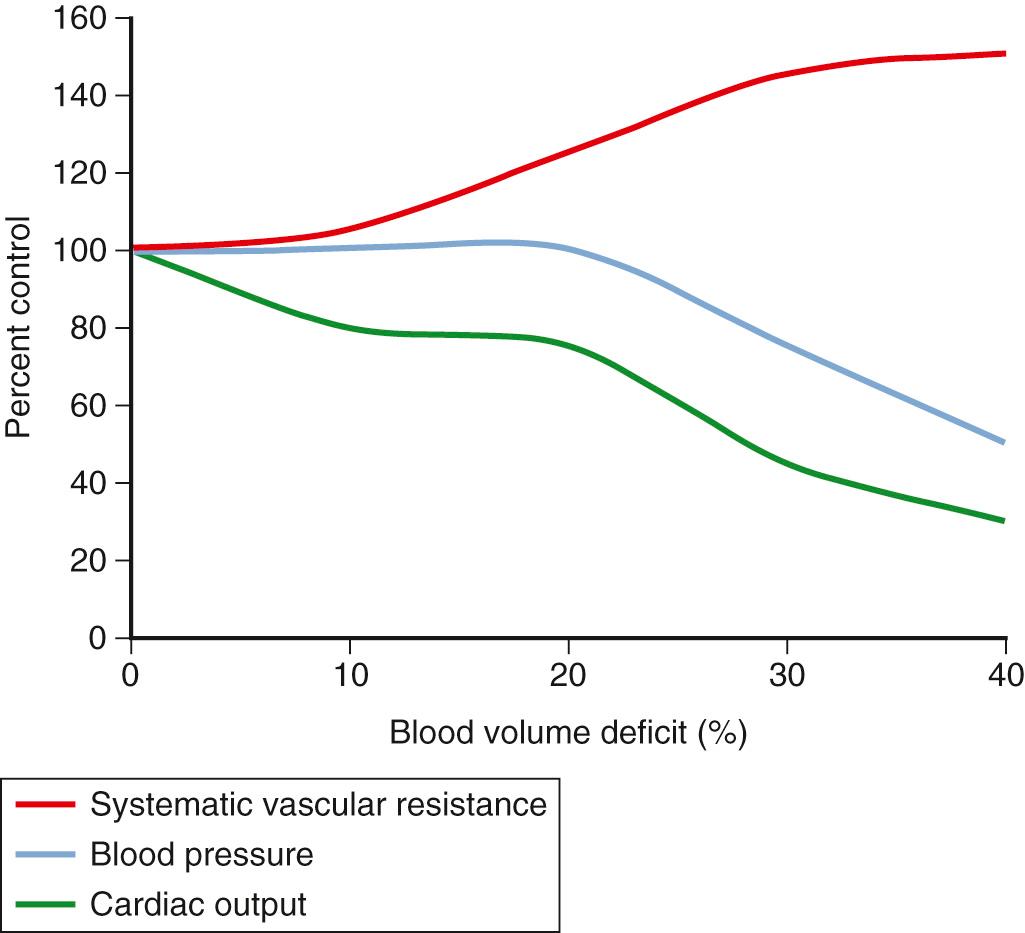
A standard classification for acute blood loss is illustrated in Table 18.1 . Understanding the physiologic responses that accompany different degrees of volume deficit can assist the clinician in managing obstetric hemorrhage. By 30 weeks of gestation, the average 70-kg pregnant woman maintains a blood volume of 6000 mL (85 mL/kg).
| Class | Acute Blood Loss (mL) | % Lost | Physiologic Response |
|---|---|---|---|
| 1 | 1000 | 10–15 | Dizziness, palpitations, minimal blood pressure change |
| 2 | 1500 | 20–25 | Tachycardia, tachypnea, sweating, weakness, narrowed pulse pressure |
| 3 | 2000 | 30–35 | Significant tachycardia and tachypnea, restlessness, pallor, cool extremities, hypotension |
| 4 | ≥2500 | 40 | Shock, air hunger, oliguria or anuria |
Class 1 hemorrhage corresponds to approximately 1000 mL of blood loss. This blood loss equates to a 10% to 15% volume deficit. Women with this amount of volume deficit exhibit mild physiologic changes, such as dizziness and palpitations, owing to the hemodynamic adaptations that accompany normal pregnancy.
Class 2 hemorrhage is characterized by 1500 mL of blood loss, or a 20% to 25% volume deficit. Early physical changes that occur during a class 2 hemorrhage include tachycardia and tachypnea. Narrowing of the pulse pressure is another sign of a class 2 hemorrhage. The pulse pressure represents the difference between the systolic and diastolic blood pressures. Systolic blood pressure is a good representation of stroke volume and β 1 stimulation. Diastolic blood pressure reflects systemic vasoconstriction; therefore the pulse pressure represents the interrelationship between these entities. With a class 2 volume deficit, the sympathoadrenal system is activated, resulting in a diversion of blood flow away from nonvital organs (skin, muscle, and kidney) and a redistribution of the circulation to vital body organs (brain and heart). The result of this activation is increased vasoconstriction, increased diastolic blood pressure, maintenance of systolic blood pressure, and a narrowing of the pulse pressure. A final physiologic response of class 2 hemorrhage is orthostatic hypotension . Although blood pressure comparisons can be made in the supine, sitting, and standing positions to document this response, a practical approach is to assess the time needed to refill a blanched hypothenar eminence on the patient's hand. Typically a woman with normal blood volume can refill her hypothenar eminence within 1 to 2 seconds after pressure is applied. A patient with a class 2 hemorrhage and orthostatic hypotension will have a significant reperfusion delay.
Class 3 hemorrhage is defined as a blood loss of 2000 mL and corresponds to a volume deficit of 30% to 35%. Within this hemorrhage class, the physiologic responses noted in class 2 hemorrhage are exaggerated. Patients demonstrate significant tachycardia (120 to 160 beats/min), tachypnea (30 to 50 breaths/min), overt hypotension, restlessness, pallor, and cool extremities.
Class 4 hemorrhage is characterized by more than 2500 mL of blood loss . This amount of blood loss exceeds 40% of the patient's total blood volume. The clinical manifestations of this volume deficit include absent distal pulses, shock, air hunger, and oliguria or anuria.
Placental abruption, or abruptio placentae, refers to the premature separation of a normally implanted placenta from the uterus prior to delivery of the fetus. The diagnosis is typically reserved for pregnancies greater than 20 weeks of gestation. Abruption is characterized by defective maternal vessels in the decidua basalis, which rupture and cause the separation. On rare occasions, the separation may be caused by a disruption of the fetal-placental vessels. These damaged vessels cause bleeding, which results in a decidual hematoma that may promote placental separation, destruction of placental tissue, and a loss of maternal-fetal surface area for nutrient and gas exchange.
A 37-year-old G5P0221 female presents to labor and delivery with abdominal pain and acute vaginal bleeding at 29 weeks of gestation. Her obstetric history is notable for a vaginal delivery of an intrauterine fetal demise at 32 weeks due to placental abruption and an emergent cesarean delivery at 30 weeks due placental abruption. She has chronic hypertension and smokes one pack of cigarettes per day. On presentation, her blood pressure is 160/90 mm Hg and she is tachycardic. She has tachysystole and a category II fetal heart rate tracing.
Although some placental abruptions occur acutely after a sudden mechanical event (e.g., blunt trauma, sudden uterine decompression, or motor vehicle accident), most cases appear to result from more chronic processes. Abnormal early development of the spiral arteries can lead to decidual necrosis, inflammation, infarction, and bleeding due to vascular disruption. Thrombin, which is released in response to decidual hemorrhage or hypoxia, appears to play an active role in the pathogenesis of placental abruption. Thrombin acts as a direct uterotonic, enhances the action of matrix metalloproteinases, upregulates apoptosis genes, increases the expression of inflammatory cytokines, triggers the coagulation cascade, and initiates functional progesterone withdrawal. These thrombin-mediated events propagate a cyclic pathway of vascular disruption, hemorrhage, inflammation, contractions, and rupture of membranes.
The overall incidence of placental abruption is 1 in 100 births . The incidence varies internationally, with higher rates in the United States compared with other countries. About one-third of all antepartum bleeding can be attributed to placental abruption. Most cases occur in the third trimester prior to 37 weeks of gestation.
The clinical manifestations of placental abruption are determined by several factors, including the temporal nature of the abruption (acute vs. chronic), the clinical presentation (overt vs. concealed), and the severity . An acute overt abruption typically presents with vaginal bleeding, abdominal and/or back pain, and uterine contractions. As the placental separation worsens, uterine tenderness, tachysystole, hypoxic fetal heart rate (FHR) patterns, maternal hypotension, coagulopathy, and fetal death may occur. The amount of vaginal bleeding correlates poorly with the extent of placental separation. In fact, 10% to 20% of placental abruptions are concealed. Abdominal pain is often a better predictor of poor maternal-fetal outcome.
Chronic abruption is often insidious in its presentation with associated ischemic placental disease. Typically these cases present with light intermittent vaginal bleeding and signs of chronic placental inflammation and dysfunction, such as oligohydramnios, fetal growth restriction, preterm labor, premature preterm rupture of membranes, and preeclampsia.
A variety of risk factors have been identified for placental abruption ( Box 18.2 ).
Prior abruption
Increasing parity and maternal age
Maternal substance use
Cigarette smoking
Cocaine and methamphetamine abuse
Trauma
Maternal diseases
Hypertension
Hypothyroidism
Asthma
Preterm premature rupture of membranes
Rapid uterine decompression associated with multiple gestation and polyhydramnios
Uterine, placental, and fetal factors
Uterine anomalies
Synechiae
Fibroids
Cesarean scar
Abnormal placental formation
Chronic ischemia
Fetal congenital malformation
Women who have had a previous abruption are at significant risk for recurrent abruption. After one abruption, the recurrence risk is 5% to 10%, whereas the risk increases to 20% to 25% after two abruptions. The risk of recurrence is greater after a severe abruption.
Some studies have noted a higher incidence of placental abruption with increasing parity and maternal age . Among primigravid women, the frequency of placental abruption is less than 1%; however, 2% to 3% of grand multiparas experience placental abruption. A large population-based study was able to demonstrate a strong relationship between maternal age and placental abruption; however, other studies suggest that there is no increased risk when parity and hypertensive disease are excluded. Theories suggest that damaged endometrium, impaired decidualization, and aberrant vasculature may have causal roles.
Cigarette smoking has consistently been associated with an increased incidence of placental abruption and fetal death. There appears to be a dose-response relationship with the number of cigarettes smoked. For each pack of cigarettes smoked, there is 40% increased risk of fetal death from placental abruption. In addition, smoking and hypertensive disease appear to have an additive effect on the likelihood of placental abruption. Proposed etiologies include placental hypoperfusion with resulting decidual ischemia and necrosis.
Cocaine and methamphetamine abuse in the third trimester has been associated with placental abruption . The pathogenesis appears to be related to substance-induced vasospasm with subsequent decidual ischemia, reflex vasodilation, and vascular disruption within the placental bed.
Placental abruption is strongly associated with blunt or penetrating trauma to the gravid abdomen. The two most common causes of maternal trauma are motor vehicle accidents and domestic abuse. With motor vehicle accidents, uterine stretch, direct penetration, and/or placental shearing from acceleration-deceleration forces are proposed etiologies.
Maternal hypertension is a consistently identified risk factor for placental abruption. This relationship has been observed with both chronic and pregnancy-related hypertensive disease. Compared with normotensive women, hypertensive women have a fivefold increased risk for placental abruption. Unfortunately antihypertensive therapy has not been shown to reduce the risk for placental abruption in women with chronic hypertension.
In addition to hypertensive disease, maternal subclinical hypothyroidism and asthma have been associated with placental abruption in some studies. There are inconsistent data regarding the association of maternal thrombophilias with placental abruption.
Placental abruption occurs in 2% to 5% of pregnancies with preterm premature rupture of membranes. Intrauterine infection and oligohydramnios significantly increase the risk for placental abruption, and nonreassuring FHR patterns occur in nearly half of these pregnancies. It is unclear whether placental abruption is the cause or consequence of preterm premature rupture of membranes. Hemorrhage and associated thrombin generation may stimulate cytokine and protease production, resulting in membrane rupture. Alternatively, the cytokine-protease cascade that follows ruptured membranes may cause damage to the decidual vasculature, which predisposes the placenta to separation.
Rapid decompression of an overdistended uterus can precipitate an acute placental abruption. This may occur in the setting of multiple gestations or polyhydramnios. Compared with singletons, twins have nearly a threefold increased risk for placental abruption. Although the exact timing of placental abruption in multiple gestations is difficult to ascertain, it has been attributed to rapid decompression of the uterus after the delivery of the first twin. Likewise, rapid loss of amniotic fluid in pregnancies complicated by polyhydramnios has been implicated in placental abruption. This can occur with spontaneous rupture of membranes or may follow therapeutic amniocentesis.
Suboptimal placental implantation in patients with uterine anomalies, synechiae, fibroids, and cesarean scars is associated with abruption. In addition, abnormal placental formation (e.g., circumvallate placenta) or chronic placental ischemia associated with preeclampsia and fetal growth restriction have been implicated in placental abruption. A case-control study of pregnancies complicated by major fetal congenital malformations suggests an increased risk of placental abruption as well.
Placental abruption is primarily a clinical diagnosis that is supported by radiographic, laboratory, and pathologic studies. Any findings of vaginal bleeding, uterine contractions, abdominal and/or back pain, or trauma should prompt an investigation for potential placental abruption. Vaginal bleeding may range from mild to severe. Unfortunately bleeding may be underestimated because it can be retained behind the placenta. The typical abruption contraction pattern is high in frequency and low in amplitude; however, it may simulate labor in some circumstances.
Although early studies evaluating the use of ultrasound for the diagnosis of placental abruption identified a small percentage of cases, recent advances in imaging and its interpretation have improved detection rates. Early hemorrhage is typically hyperechoic or isoechoic, whereas resolving hematomas are hypoechoic within 1 week and sonolucent within 2 weeks of the abruption. Acute hemorrhage may be misinterpreted as a homogeneous thickened placenta or fibroid.
Ultrasound can identify three predominant locations for placental abruption : subchorionic (between the placenta and the membranes), retroplacental (between the placenta and the myometrium), and preplacental (between the placenta and the amniotic fluid). Fig. 18.2 illustrates the classification of hematomas in relation to the placenta. Fig. 18.3 demonstrates a sonographic image of a subchorionic abruption.
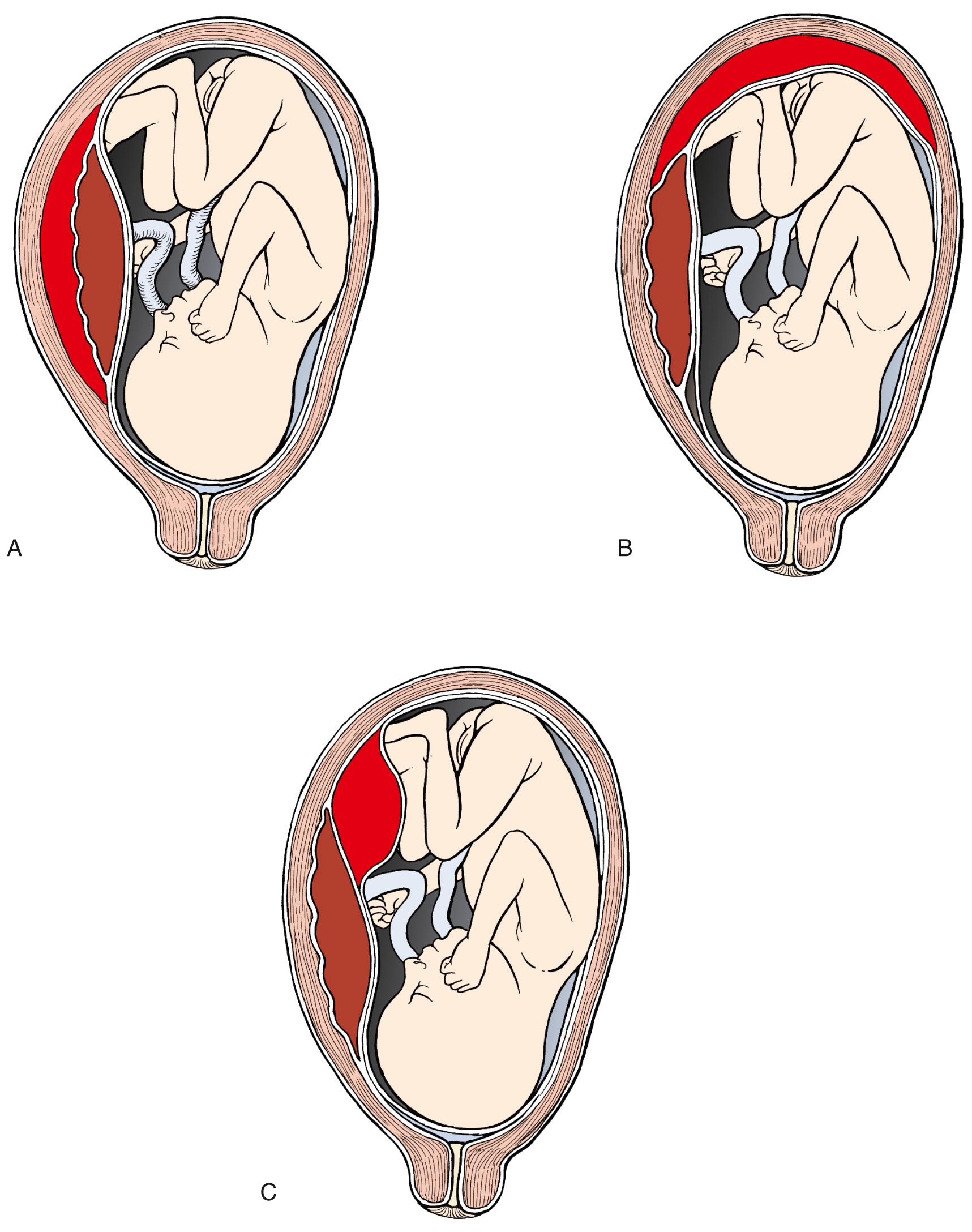
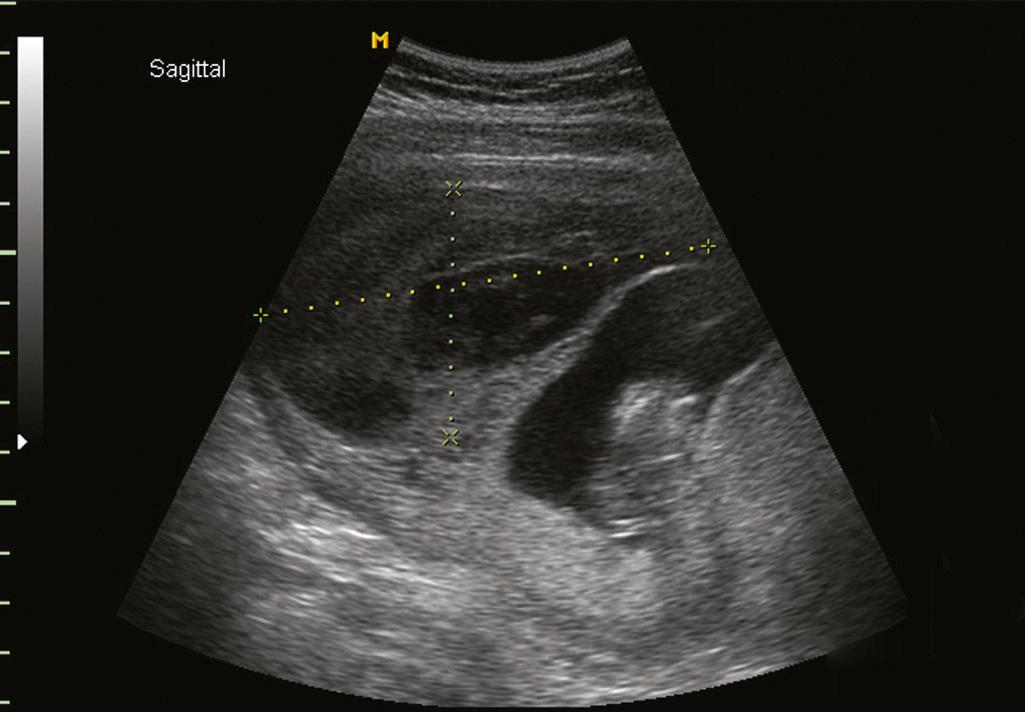
The location and extent of the placental abruption identified on ultrasound examination is of clinical significance. Retroplacental hematomas are associated with a worse prognosis for fetal survival than subchorionic hematomas. The size of the hemorrhage is also predictive of fetal survival. Large retroplacental hematomas (>60 mL) have been associated with a 50% risk of fetal mortality, whereas similarly sized subchorionic hematomas carry less than a 10% risk.
Magnetic resonance imaging (MRI) can be used for the diagnosis of placental abruption when sonography is equivocal.
Few laboratory studies assist in the diagnosis of placental abruption. Hypofibrinogenemia and evidence of consumptive coagulopathy may accompany severe abruption ; however, clinical correlation is necessary. Moreover, most abruptions are not accompanied by maternal coagulopathy.
Abnormal maternal serum aneuploidy markers early in pregnancy—such as an elevated unexplained maternal serum α-fetoprotein or human chorionic gonadotropin, decreased pregnancy-associated plasma protein A or unconjugated estriol, and decreased or elevated inhibin-A—have been associated with an increased risk for subsequent placental abruption. In addition, a low fetal fraction on first-trimester cell-free DNA aneuploidy screening has been associated with an increased risk of obstetric morbidity, including abruption.
Macroscopic inspection of the placenta may demonstrate adherent clot and depression of the placental surface. Acute placental abruptions may not have any identifiable evidence on gross pathologic examination, but histologic analysis may show preservation of the villous stroma, eosinophilic degeneration of the syncytiotrophoblast, and scattered neutrophils with villous agglutination. Chronic abruptions may demonstrate histologic signs of chronic deciduitis, maternal floor decidual necrosis, villitis, decidual vasculopathy, infarction, intervillous thrombosis, villous maldevelopment, and hemosiderin deposition.
Both maternal and fetal complications may occur with placental abruption. Maternal complications include blood loss, consumptive coagulopathy, need for transfusion, end-organ damage, cesarean delivery, peripartum hysterectomy, and death. Recent data also suggests an increased risk of future premature cardiovascular disease and death in women with a history of placental abruption. Fetal complications include fetal growth restriction, oligohydramnios, prematurity, hypoxemia, and stillbirth. Although maternal complications are related to the severity of the abruption, fetal complications are related to both the severity and timing of the hemorrhage.
Management of placental abruption depends on its severity as well as gestational age and maternal-fetal status. Once the diagnosis of placental abruption has been made, precautions should be taken to anticipate the possible life-threatening consequences for both mother and fetus. These precautions include baseline laboratory assessment (hemoglobin, hematocrit, platelet count, type and screen, fibrinogen, coagulation studies, complete metabolic profile, and urine toxicology screen), appropriate intravenous (IV) access (one or two large-bore catheters), maternal hemodynamic monitoring, IV fluid resuscitation, blood-loss quantification, availability of blood products, continuous FHR and contraction monitoring, and communication with anesthesia, operating room (OR), and neonatal personnel.
Fig. 18.4 demonstrates a general management algorithm for placental abruption. The initial fetal assessment will dictate subsequent management. If the fetus is dead, the maternal status must be assessed rapidly. An unstable mother often presents with hemodynamic instability and/or coagulopathy. In these scenarios, immediate intravascular volume and blood product replacement are essential. Often cesarean delivery is favored to expedite recovery; however, clinical discretion is advised, since surgery can result in uncontrollable bleeding and an increased need for hysterectomy. If maternal hemodynamic stability can be achieved, vaginal delivery is preferred. Serial assessments of coagulation studies are advised with replacement of blood products as clinically indicated.
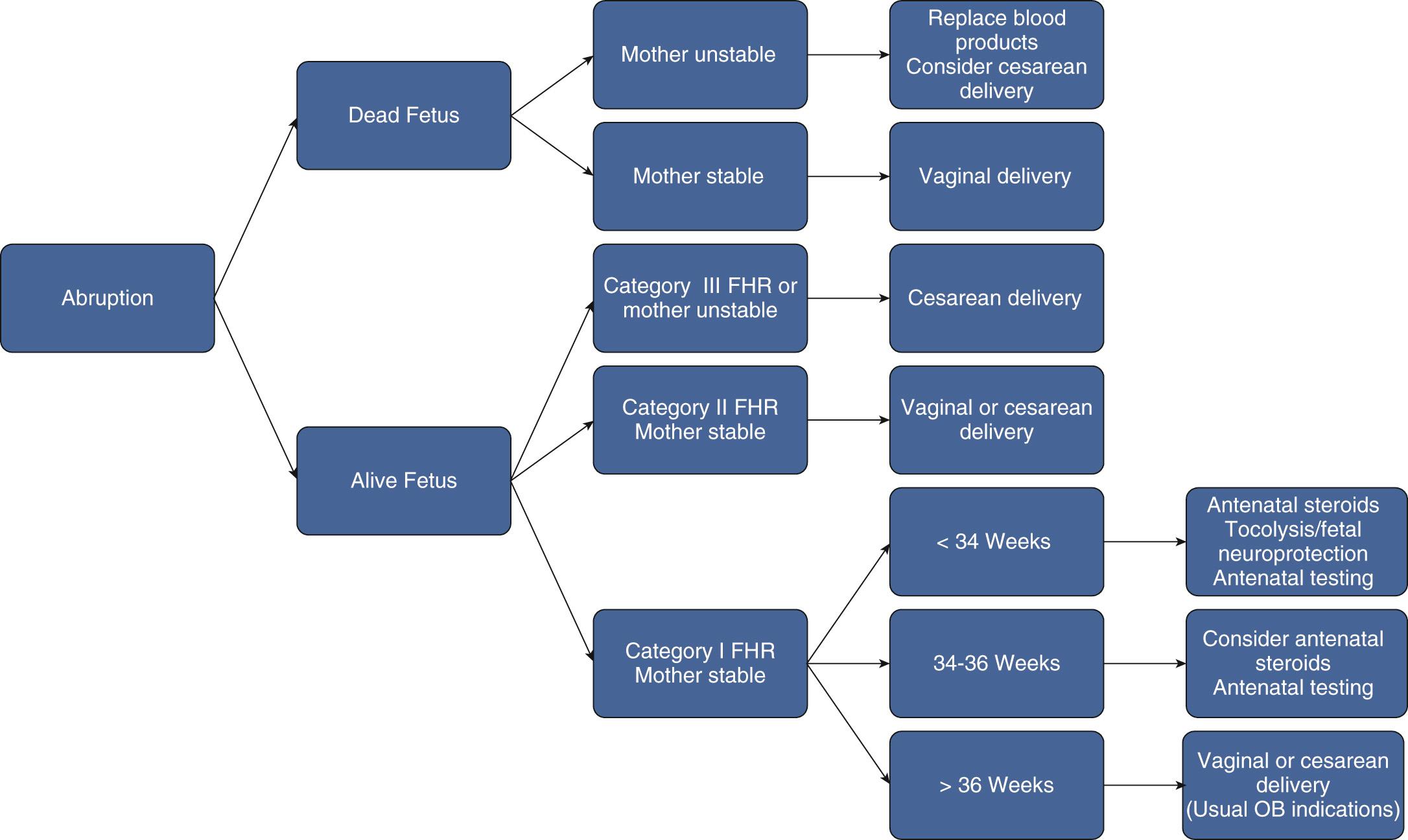
If the fetus is alive and the mother is stable, management is dependent on the clinical FHR pattern and gestational age. A category III FHR tracing is an indication for delivery. Unless vaginal delivery is imminent, cesarean delivery is typically advised regardless of gestational age. Category II FHR tracings can be managed expectantly in some settings; however, when an abruption is the etiology, rapid fetal decompensation can occur. In most cases, delivery is preferred, with the mode dependent on the clinical circumstances (e.g., maternal hemodynamic status, cervical ripeness, and progression of FHR pattern). When the fetal status is reassuring with a category I FHR tracing, management is dictated by the gestational age. Small placental abruptions remote from term (<34 weeks) may be managed expectantly. In most circumstances, hospitalization is recommended so that antenatal corticosteroids, magnesium neuroprotection, and antenatal testing can be provided. When chronic abruption occurs, a cycle of bleeding, thrombin generation, contractions, and further placental separation occurs. In these settings a short course of tocolysis (48 hours) may help to prevent contractions and thus break the abruption cycle. When a woman presents late preterm (34 to 36 weeks of gestation), management is contingent on both fetal and maternal status. If both are reassuring, antenatal corticosteroids and antenatal testing may be considered. If there is any evidence of compromise, delivery is recommended. Women who present at or near term (>36 weeks) with a placental abruption should undergo delivery.
Induction or augmentation of labor is not contraindicated in the setting of an abruption; however, close surveillance for any evidence of maternal or fetal compromise is advised. Up to 60% of fetuses may exhibit intrapartum heart rate patterns consistent with hypoxemia. Intrauterine pressure catheter placement, and internal FHR monitoring can assist the clinician during the intrapartum course. Maternal hemodynamic and clotting parameters must be followed closely to detect signs of evolving coagulopathy. Although vaginal delivery is preferable, operative delivery is often necessary owing to fetal and/or maternal decompensation. When cesarean delivery is required, a rapid decision-to-delivery time is optimal because an interval of less than 20 minutes from the onset of fetal bradycardia is associated with improved outcomes. Occasionally a Couvelaire uterus may be noted at the time of cesarean delivery. This is characterized by the extravasation of blood into the myometrium and is often associated with uterine atony. Prompt uterotonic therapy and surgical intervention should be employed, with hysterectomy reserved for refractory cases.
Placental abruption is associated with increased perinatal morbidity and mortality. As compared with normal pregnancies, pregnancies complicated by abruption have a 10-fold increased risk for perinatal death. In addition, other studies of neonatal outcomes after placental abruption suggest that there are greater risks for adverse long-term neurobehavioral development , hypoxia-associated periventricular leukomalacia, and sudden infant death syndrome.
Placenta previa is defined as the presence of placental tissue over the cervical os. Contemporary classification of placenta previa consists of two variations: placenta previa, in which the internal cervical os is covered by placental tissue, and low-lying placenta, in which the placenta lies within 2 cm of the cervical os but does not cover it. Although not a true placenta previa, a low-lying placenta is associated with an increased risk for bleeding and other adverse pregnancy events.
A 30-year-old G3P2002 female presents to labor and delivery with painless vaginal bleeding at 31 weeks of gestation. Her obstetric history is notable for one vaginal delivery at term and one cesarean delivery at term due to malpresentation. Both of her pregnancies were the result of assisted reproductive technology. She reports that her placenta is “near the cervix.” On presentation, her blood pressure is 120/84 mm Hg, her pulse is 105 beats/min, and her pants are saturated with blood. A category I fetal heart rate pattern is noted.
The overall reported incidence of placenta previa at delivery is 1 in 200 to 300 births. In the second trimester, placenta previa occurs in 2% to 6% of pregnancies; therefore over 90% resolve by the time of delivery. The term placental migration has been used to explain this “resolution” of placenta previa noted near term. Two theories have been suggested to account for this phenomenon. The first proposes that as the pregnancy advances, the stationary lower placental edge relocates away from the cervical os with the development of the lower uterine segment. The second theory suggests that trophotropism, or the growth of trophoblastic tissue away from the cervical os toward the fundus, results in resolution of the placenta previa.
Placenta previa typically presents as painless vaginal bleeding in the second or third trimester. The bleeding is believed to occur from disruption of placental blood vessels in association with the development and thinning of the lower uterine segment. Nearly 90% of patients with placenta previa will have at least one bleeding episode. About 10% to 20% of patients present with uterine contractions before the onset of bleeding, and fewer than 10% remain asymptomatic until term. Of those with bleeding, one-third will present before 30 weeks of gestation, one-third between 30 and 36 weeks, and one-third after 36 weeks. Early-onset bleeding (<30 weeks) carries the greatest risk for blood transfusion and associated perinatal morbidity and mortality. In addition, the number of antepartum bleeding episodes and need for transfusion have both been independently associated with need for emergent cesarean delivery.
Several risk factors for placenta previa have been noted ( Box 18.4 ). Additionally, some reports have documented a higher association of fetal malpresentation, preterm labor, preterm premature rupture of membranes, intrauterine growth restriction, congenital anomalies, and amniotic fluid embolism with placenta previa.
Prior placenta previa
Prior cesarean delivery and uterine surgery
Intrinsic maternal factors
Increasing parity
Advanced maternal age
Maternal race
Extrinsic maternal factors
Cigarette smoking
Cocaine use
Assisted reproductive technology
Fetal factors
Multiple gestations
Male fetus
Having had a prior placenta previa increases the risk for the development of another previa in a subsequent pregnancy. This association has been reported to be as high as 4% to 8%. The exact etiology for this increased risk is unclear.
Prior uterine surgery has been associated with the formation of placenta previa . Although a history of curettage and/or myomectomy attends a slightly elevated previa risk, prior cesarean delivery has been the most consistent risk factor. There appears to be a linear increase in the risk of placenta previa with the number of prior cesarean deliveries . Endometrial scarring is thought to be the etiologic factor for this increased risk.
Studies have reported more cases of placenta previa with increasing parity . Grand multiparas have a 5% risk for placenta previa compared with less than 1% among nulliparous women. Maternal age also seems to influence the occurrence of placenta previa. Women older than 35 years of age have more than a fourfold greater risk for placenta previa, and women older than 40 years of age have a ninefold greater risk. Finally, nonwhite maternal race has been associated with placenta previa.
Cigarette smoking has been associated with as high as a threefold increased risk for previa formation. Likewise, maternal cocaine use increases the risk of placenta previa fourfold. Finally, pregnancy that has resulted from assisted reproductive technology is statistically associated with higher rates of placenta previa.
Most studies have demonstrated an increased risk for placenta previa with multiple gestations . Dichorionic twins have a significantly higher risk for placenta previa than monochorionic gestations. A consistently higher proportion of offspring in women with placenta previa are male. This association is unexplained; however, two theories suggest larger placental sizes among male fetuses and delayed implantation of the male blastocyst in the lower uterine segment.
The timing of the diagnosis of placenta previa has undergone significant change in the past five decades. Painless third-trimester bleeding was a common presentation for placenta previa in the past, whereas most cases of placenta previa are now detected antenatally with ultrasound prior to the onset of significant bleeding.
Transabdominal and transvaginal ultrasound provide the best means for diagnosing placenta previa. Although transabdominal ultrasound can detect the majority of placenta previa cases, transvaginal ultrasound has a reported diagnostic accuracy that approaches 100%. Transvaginal ultrasound is safe and is not contraindicated in these circumstances. Of note, good-quality images can be obtained using transvaginal ultrasound without any contact between the probe and the cervix ( Fig. 18.5 ).
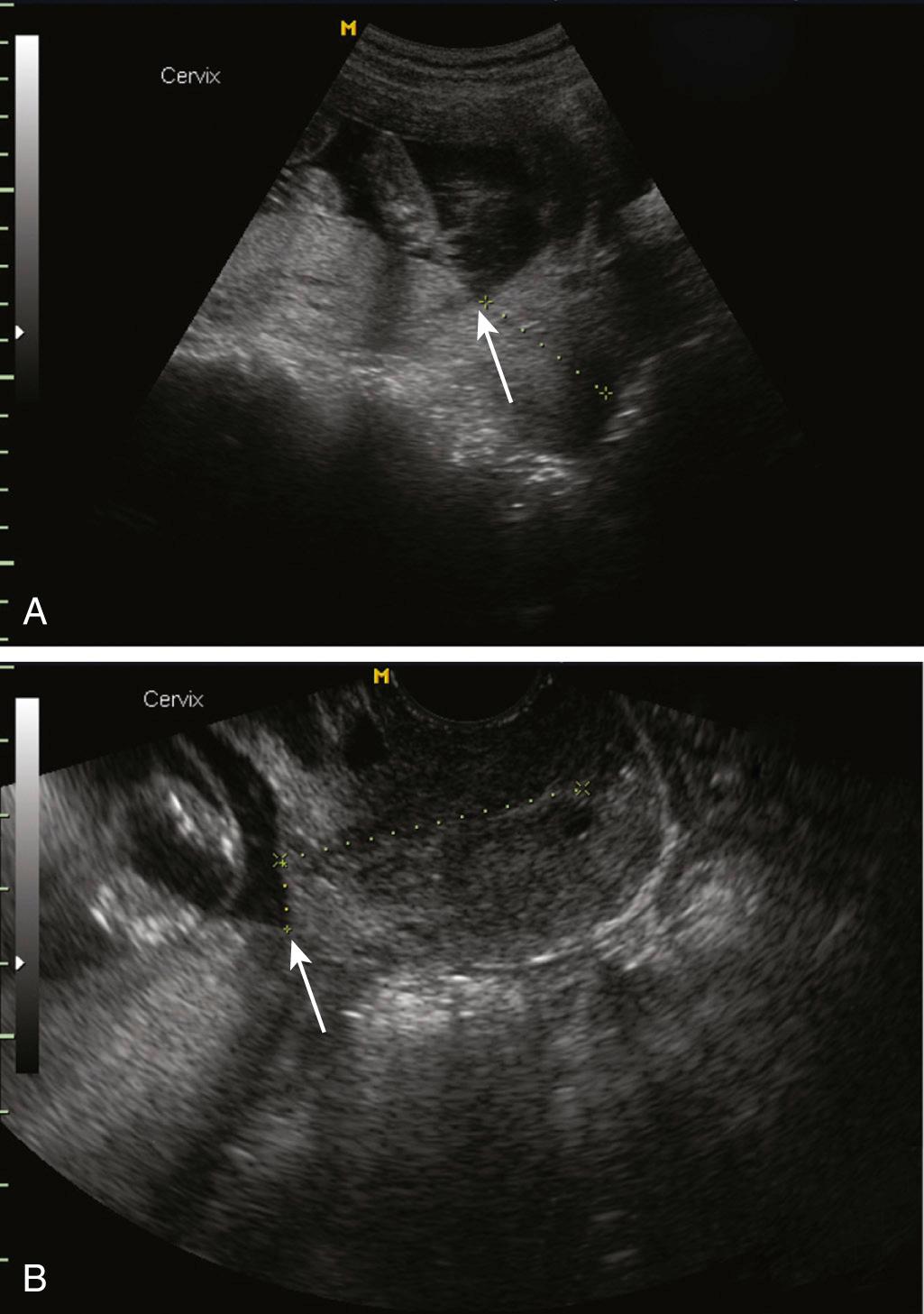
If a placenta previa or low-lying placenta is diagnosed in the second trimester, repeat sonography should be obtained in the early third trimester or at 32 weeks. Over 90% of placenta previa cases diagnosed in the second trimester resolve by the late third trimester . The potential for placenta previa resolution is dependent on the timing of the diagnosis, extension over the cervical os, and placental location. For example, one study of 714 women with an ultrasound diagnosis of placenta previa noted that the earlier the diagnosis, the more likely the previa would resolve by term ( Table 18.2 ). In addition, a placenta previa greater than 2.5 cm over the cervical os in the second trimester is more likely to persist into the third trimester, whereas a low-lying placenta will persist in less than 5% of cases. Finally, anterior placenta previa is more likely to migrate away from the cervical os than posterior placement.
| Gestational Age at Diagnosis (Weeks) | Previa at Term (%) |
|---|---|
| 15–19 | 12 |
| 20–23 | 34 |
| 24–27 | 49 |
| 28–31 | 62 |
| 32–35 | 73 |
Occasionally MRI may be used to diagnose placenta previa. MRI is particularly helpful with the identification of posterior placenta previa and the assessment of invasive placentation (see further on).
General management principles for patients with placenta previa in the third trimester include serial ultrasounds to assess placental location and fetal growth, avoidance of cervical examinations and intercourse, activity restrictions, counseling regarding labor symptoms and vaginal bleeding, dietary and nutrient supplementation to avoid maternal anemia, and early medical attention if any vaginal bleeding occurs. Fig. 18.6 provides an algorithm for the management of placenta previa.

Specific recommendations for the management of asymptomatic placenta previa have been provided by a work group from the National Institute of Child Health and Human Development. For pregnancies at greater than 16 weeks of gestation with a low-lying placenta or a placenta previa, repeat ultrasound to assess placental location is recommended at 32 weeks. If a low-lying placenta or placenta previa persists at 32 weeks, repeat sonography is again obtained at 36 weeks.
Asymptomatic women with placenta previa may be managed expectantly as outpatients. Factors associated with a higher risk of antepartum bleeding include complete placental coverage of the cervical os, a thickened placental edge, an echo-free placental space over the cervical os, and a cervical length of less than 3 cm. Despite these sonographic findings, it is not possible to predict all cases of bleeding resulting from placenta previa. With this in mind, asymptomatic patients should be instructed to avoid activities that may stimulate uterine contractions and/or cervical irritation, such as strenuous exercise, intercourse, and digital cervical examinations. Several studies have documented the safety, efficacy, and cost-effectiveness of outpatient management for asymptomatic placenta previa. Candidates for outpatient management must (1) be compliant, (2) live within a short commute from the hospital, (3) have 24-hour emergency transportation to the hospital, and (4) verbalize a thorough understanding of the risks associated with placenta previa.
Women with placenta previa who present with acute vaginal bleeding require hospitalization and immediate evaluation to assess maternal-fetal stability . They should initially be managed in a labor and delivery unit with hemodynamic surveillance of the mother and continuous FHR monitoring. Large-bore IV access and baseline laboratory studies (hemoglobin, hematocrit, platelet count, blood type and screen, and coagulation studies) should be obtained. If the pregnancy is at less than 32 weeks of gestation, magnesium sulfate neuroprotection should be considered . In addition, administration of antenatal corticosteroids should be undertaken for all gestations of less than 34 weeks . An assessment of the facility's emergency resources for both the mother and neonate is necessary. In some cases maternal transport and consultations with maternal-fetal medicine and neonatology may be warranted. Finally, tocolysis may be considered in selected cases if the vaginal bleeding is preceded by or associated with uterine contractions.
Once stabilized, most women with symptomatic placenta previa can be maintained on hospitalized bed rest and expectantly managed . The minimization of maternal anemia by using blood conservation techniques is recommended. Although some patients may require transfusion, many can be supplemented with iron replacement (oral or IV), vitamin C to enhance oral iron absorption, and B vitamins. Erythropoietin may be used in selected cases to hasten red cell formation. Lastly, autologous donation may be considered in patients with hemoglobin concentrations greater than 11 g/dL.
A bleeding placenta previa can cause disruption of the maternal-fetal interface and potentially lead to a loss of fetal blood. Anti-D immune globulin should be administered to all Rh-negative unsensitized women with a bleeding placenta previa. A Kleihauer-Betke preparation of maternal blood should be considered in these circumstances. Occasionally a fetomaternal hemorrhage of greater than 30 mL occurs, necessitating additional doses of anti-D immune globulin.
Cesarean delivery is indicated for all women with sonographic evidence of placenta previa and many women with low-lying placentas . Cesarean delivery rates and bleeding before the onset of labor are higher for women with low-lying placentas within 10 mm of the cervical os than for those with placental edges greater than 10 mm from the cervical os. If a vaginal trial of labor is attempted for a low-lying placenta, precautions should be taken for the possibility of an emergent cesarean delivery and need for blood transfusion.
According to a National Institute of Child Health and Human Development consensus panel, cesarean delivery of asymptomatic placenta previa with normal fetal growth and no other medical indications should occur between 36 and 37 weeks of gestation. In cases of complicated placenta previa, delivery should occur immediately regardless of gestational age . Complicated placenta previa includes bleeding associated with a nonreassuring fetal heart pattern despite resuscitative measures, life-threatening maternal hemorrhage, and/or refractory labor.
When a cesarean delivery for placenta previa is being performed, the surgeon should be aware of the potential for rapid blood loss during the delivery process . Blood products that are cross-matched should be readily available for delivery. In addition, before incising the lower uterine segment, the surgeon should assess the vascularity of this region. Although a low transverse incision is not contraindicated in patients with placenta previa, performing a vertical uterine incision may be preferable in some cases. This is particularly true with an anterior placenta previa. Ideally the placenta should not be disrupted when the uterus is entered. If disruption occurs, expedited delivery is essential. Given the potential for invasive placentation, the physician should allow the placenta to deliver spontaneously. If it does not separate easily, precautions should be taken for the management of placenta accreta syndrome (PAS; see further on). Once the placenta has separated, bleeding is controlled by the contraction of uterine myometrial fibers around the spiral arterioles. Because the lower uterine segment often contracts poorly, significant bleeding may occur from the placental implantation site. Aggressive uterotonic therapy, administration of tranexamic acid, surgical intervention, and/or tamponade techniques should be undertaken to control bleeding rapidly. Finally, some studies have shown reduced bleeding at the placental site with the injection of vasopressin after delivery of the fetus.
PAS represents the abnormal attachment of the placenta to the uterine lining due to defective development of decidua basalis and fibrinoid layer . PAS includes placenta accreta, in which the placenta adheres abnormally to the myometrium; placenta increta, in which it adheres into the myometrium; and placenta percreta, in which it extends through the myometrium to the uterine serosa and/or adjacent organs ( Fig. 18.7 ).
A 36-year-old G8P5025 female presents at 20 weeks of gestation for her detailed fetal anatomic ultrasound. Her obstetric history is notable for five prior cesarean deliveries. On ultrasound examination, she has a placenta previa characterized by large lacunae, abnormal vasculature, and a loss of the bladder line.
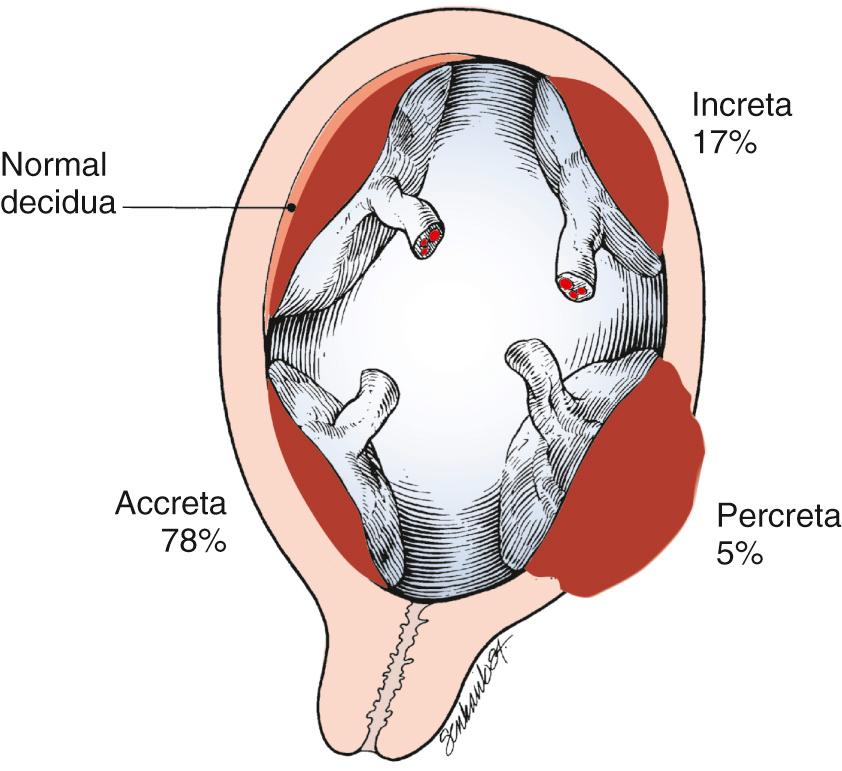
The overall incidence of PAS is 1 in 500 to 700 births. Based on histologic diagnosis, placenta accreta is the most common form of invasive placentation (79%), followed by placenta increta (14%) and placenta percreta (7%), respectively. The two most significant risk factors for PAS are placenta previa and prior cesarean delivery. The risk for PAS in patients with placenta previa and an unscarred uterus is approximately 3%. This risk dramatically increases with one or more cesarean deliveries ( Table 18.3 ). Even without a coexisting placenta previa, PAS is more common in women with a prior cesarean delivery.
| No. of Prior Cesarean Deliveries | Placenta Accreta Risk (%) |
|---|---|
| 0 | 3 |
| 1 | 11 |
| 2 | 40 |
| 3 | 61 |
| ≥4 | 67 |
Other reported risk factors include increasing parity and maternal age, submucosal uterine fibroids, prior uterine surgery, cesarean scar pregnancy, assisted reproductive technology, need for manual placental removal, prior postpartum endometritis, history of pelvic irradiation, uterine malformations, and endometrial defects or ablation . Unlike the case with placenta previa, a female fetus is more common with invasive placentation.
Become a Clinical Tree membership for Full access and enjoy Unlimited articles
If you are a member. Log in here